Introduction
Necrotizing fasciitis is a rare but fatal infection,
characterized by the rapid progression of necrosis of the fascia,
skin, soft tissue and muscle. The most common bacteria associated
with necrotizing fasciitis is group A streptococcus,
however, other pathogens, including Clostridium, Vibrio
vulnificus and Bacteroides fragilis have been implicated
(1). Pseudomonas is a rare
pathogen that causes necrotizing fasciitis (2). In the present study, a case of
community-acquired necrotizing fasciitis with septic shock due to
Pseudomonas aeruginosa is presented, as well as a review of
the literature on the current therapeutic strategies for this
condition.
Case report
A 65-year-old male was admitted to the Emergency
department of The First Affiliated Hospital of Wenzhou Medical
University (Wenzhou, Zhejiang, China) due to a one-day history of
fever and pain in his left leg. The patient had a history of
myeloma approximately one year prior to admission, which was
treated with four cycles of chemotherapy. This was followed by oral
medication therapy (melphalan, dexamethasone and thalidomide). In
addition, the patient had a history of type 2 diabetes mellitus for
two years and hypertension for three years. The patient had no
history of leg ulcers or direct trauma to the lower limbs prior to
admission.
On the day of admission, at 6:00 am, the patient was
febrile with a temperature of 39.4°C and presented with
hypertension (70–80/40–50 mmHg). Physical examination revealed
swelling and pyrexia of the left lower limb. Initial blood
investigations revealed a decrease in white cell count of
1.18×109/l and elevated levels of C-reactive protein
(76.70 mg/l). The arterial blood gas values were as follows: pH
7.24; PaO2, 108.2 mmHg; PaCO2, 18.9 mmHg;
HCO3, −19.6 mmol/l; and base excess (BE), −12.3 mmol/l.
The level of creatine kinase (CK) was markedly increased (1208
U/l), while the CK-MB level was only slightly increased (26 U/l)
and the level of troponin T was normal (<0.01 μg/l), suggesting
the presence of rhabdomyolysis. Ultrasonography revealed
subcutaneous edema of the lower limbs, which was more marked in the
left limb (Fig. 1). No gas
formation was observed in either leg and deep vein thrombosis was
also not observed. The clinical characteristics of the patient
indicated lower limb necrotizing fasciitis (stage 3) and bacterial
septic shock. Early fluid resuscitation was initiated and
norepinephrine was administered intravenously according to the
central venous pressure and mean arterial pressure. Blood and
bullous fluid samples from the affected skin were obtained, and
empiric antimicrobial therapy (piperacillin sodium/tazobactam
sodium and linezolid) was initiated. Due to the marked neutropenia,
a complete workup for immunodeficiency was performed in association
with the empirical use of human immunoglobulin and recombinant
human granulocyte colony-stimulating factor (rhG-CSF).
The patient was admitted to the emergency intensive
care unit (EICU) at 15:00 and was administered norepinephrine
intravenously. However, the patient was not able to maintain
hemodynamic stability. The respiratory rate of the patient was
40–60 breaths/min and his heart rate ranged between 130 and 150
beats/min. The arterial blood gas values were as follows: pH 7.040;
PaO2, 48.5 mmHg; PaCO2, 72.5 mmHg;
HCO3, −19.6 mmol/l; and BE, −12.3 mmol/l. Endotracheal
intubation was performed and mechanical ventilation was
established. An emergency bedside echocardiology was obtained to
exclude heart disease. Emergency incision and drainage was then
performed on the patient. Subcutaneous vein thrombosis,
subcutaneous tissue necrosis as well as muscle and full-thickness
necrosis were observed during the surgery. Necrotizing fasciitis
was confirmed by exploration and pathological examination, and
fluid aspirate was sent for immediate culture. Continuous renal
replacement therapy was then initiated. When the hemodynamics of
the patient returned to normal, an additional debridement was
performed. All infected and necrotic skin as well as subcutaneous
tissue were radically excised up to the bleeding healthy edges
(Fig. 2).
However, despite the treatments mentioned above, the
clinical condition of the patient did not improve. The platelet
count of the patient continued to decline and coagulation disorders
were not able to be modified. At this time, linezolid was replaced
with teicoplanin. P. aeruginosa was isolated from the blood
culture and bullous fluid of the affected tissue four days after
admission, however, no anaerobe was isolated. Based on the
susceptibility test results, treatment with teicoplanin was
discontinued and piperacillin/tazobactam sodium treatment was
continued as definitive therapy. Following 10 days in EICU, the
patient suddenly lost consciousness. Cyanosis was observed, as well
as mydriasis and the papillary light reflex was lost. The heart
rate of the patient decreased to 30–40 beats/min and
cardiopulmonary resuscitation was immediately initiated. However,
the patient deteriorated rapidly and succumbed to multiple organ
failure. Written informed consent was obtained from the patient for
publication of this case report and any accompanying images.
Discussion
Necrotizing fasciitis and sepsis caused by P.
aeruginosa is a rare but life-threatening disease, which occurs
more frequently in patients suffering from alcoholism, diabetes or
immunocompromised conditions (3).
In the present case study, the patient presented with neutropenia,
which was possibly secondary to the immunosuppressive medication
and septic shock. In addition, the patient had diabetes mellitus,
which may also lead to immune system dysfunction. Stopping the
administration of immunosuppressive drugs and administering rhG-CSF
in neutropenic patients may improve clinical outcomes (4). In the present case, the neutrophil
count returned to normal after treatment with G-CSF for 4 days.
However, no marked clinical improvement was observed, which may be
due to the rapid progression of the disease complicated with septic
shock and multiple organ dysfunction syndromes (MODS).
The serious complications of necrotizing fasciitis,
including septic shock and MODS, require fluid resuscitation,
antimicrobial therapy and early aggressive surgical debridement
(3). The initial hemodynamic
resuscitation of the patient was performed according to early
goal-directed therapy (EGDT), which has been demonstrated to
decrease mortality in patients with severe sepsis and septic shock
(5,6). In addition, previous studies have
demonstrated that the administration of appropriate antibiotics is
one of the various early resuscitation interventions that need to
be performed within 1 h of qualification of EGDT in patients with
critical infections (5,6). Therefore, the patient received
initial combination therapy of piperacillin/tazobactam sodium and
linezolid immediately following collection of a blood sample and
bullous fluid from the affected skin. When thrombocytopenia was
detected, teicoplanin was administered instead of linezolid.
Following completion of the antimicrobial susceptibility test,
teicoplanin treatment was discontinued and piperacillin/tazobactam
sodium was continued as the definitive therapy.
Cefoperazone/sulbactam sodium was not selected due to the potential
to cause coagulation disorders.
Continuous renal replacement therapy (CRRT) was
performed when the patient reached state 2 AKI according to Acute
Kidney Injury Network (AKIN) criteria. Several experimental and
clinical studies have previously reported that blood purification
therapies are effective in restoring immune function by clearing
inflammatory mediators from the plasma, as well as improving
physiological parameters, including hemodynamics and oxygenation
(7). CRRT is the preferred mode of
renal replacement in sepsis-induced acute kidney injury (AKI). The
data from the acute tubular necrosis and renal studies indicated
that vasopressor-dependent ICU patients on CRRT evolve to chronic
dialysis less frequently compared with patients who receive
intermittent therapies (8).
Furthermore, CRRT is recommended during the acute phase of AKI,
particularly in patients with severe hemodynamic instability or
when extensive fluid removal may allow more effective drug therapy
(8). However, it must be taken
into account that numerous antibiotics are largely removed by
continuous renal replacement therapies (9). In the present case study, the
pharmacokinetic characteristics of piperacillin/tazobactam were not
measured. However, the adequacy of piperacillin/tazobactam 4.0/0.5
every 8 h was reported in a study of nine patients on CRRT who
maintained concentrations >125 μg/ml for the whole time interval
(10).
Previous studies have demonstrated that prompt and
radical surgical debridement is an effective treatment for
necrotizing fasciitis. Delaying surgery by 24 h increased the
mortality rate associated with necrotizing soft tissue infections
from 35 to 53%, with 100% mortality if surgery is not performed
within three days (11). The
ultimate outcome of the patient also depends on the completeness of
surgical debridement (12); the
excision margin should be healthy bleeding tissue with a normal
appearance (11,12). However, our previous study
demonstrated that, compared with radical surgical debridement,
incision and drainage was also effective and safe, particularly in
patients with septic shock complicated with MODS and severe
coagulation disorders (13).
Additionally, this type of surgical approach is simple, quick and
results in little blood loss (13). Therefore, in the present case
study, incisions and drainage of the involved extremities were
performed. Selective debridement was then performed once the
hemodynamics of the patient had stabilized. However, the patient
succumbed to sepsis-induced MODS.
In conclusion, in the present study, a case of
community-acquired P. aeruginosa necrotizing fasciitis
complicated with septic shock and MODS was reported. Due to the
rapid progression and high mortality rate of the disease, early
surgery, as well as novel therapeutic approaches for septic shock,
are required to improve the outcome of patients.
Acknowledgements
This study was supported, in part, by a grant from
the key construction academic subject (medical innovation) of
Zhejiang Province (11-CX26).
References
|
1
|
Sarani B, Strong M, Pascual J and Schwab
CW: Necrotizing fasciitis: current concepts and review of the
literature. J Am Coll Surg. 208:279–288. 2009. View Article : Google Scholar : PubMed/NCBI
|
|
2
|
Akamine M, Miyagi K, Uchihara T, et al:
Necrotizing fasciitis caused by Pseudomonas aeruginosa.
Intern Med. 47:553–556. 2008. View Article : Google Scholar
|
|
3
|
Anaya DA and Dellinger EP: Necrotizing
soft-tissue infection: diagnosis and management. Clin Infect Dis.
44:705–710. 2007. View
Article : Google Scholar : PubMed/NCBI
|
|
4
|
Crawford J, Ozer H, Stoller R, et al:
Reduction by granulocyte-colony stimulating factor of fever and
neutropenia induced by chemotherapy in patients with small-cell
lung cancer. N Engl J Med. 325:164–170. 1991. View Article : Google Scholar : PubMed/NCBI
|
|
5
|
Dellinger RP, Levy MM, Rhodes A, et al:
Surviving Sepsis Campaign Guidelines Committee including the
Pediatric Subgroup: Surviving sepsis campaign: international
guidelines for management of severe sepsis and septic shock: 2012.
Crit Care Med. 41:580–637. 2013.
|
|
6
|
Gaieski DF, Mikkelsen ME, Band RA, et al:
Impact of time to antibiotics on survival in patients with severe
sepsis or septic shock in whom early goal-directed therapy was
initiated in the emergency department. Crit Care Med. 38:1045–1053.
2010. View Article : Google Scholar
|
|
7
|
Rimmelé T and Kellum JA: Clinical review:
blood purification for sepsis. Crit Care. 15:2052011.PubMed/NCBI
|
|
8
|
Honore PM, Jacobs R, Joannes-Boyau O, et
al: Septic AKI in ICU patients. diagnosis, pathophysiology, and
treatment type, dosing, and timing: a comprehensive review of
recent and future developments. Ann Intensive Care. 1:322011.
View Article : Google Scholar : PubMed/NCBI
|
|
9
|
Roberts DM, Roberts JA, Roberts MS, et al:
Variability of antibiotic concentrations in critically ill patients
receiving continuous renal replacement therapy: a multicentre
pharmacokinetic study. Crit Care Med. 40:1523–1528. 2012.
View Article : Google Scholar
|
|
10
|
Mueller SC, Majcher-Peszynska J, Hickstein
H, et al: Pharmacokinetics of piperacillin-tazobactam in anuric
intensive care patients during continuous venovenous hemodialysis.
Antimicrob Agents Chemother. 46:1557–1560. 2002. View Article : Google Scholar : PubMed/NCBI
|
|
11
|
Kobayashi L, Konstantinidis A, Shackelford
S, et al: Necrotizing soft tissue infections: delayed surgical
treatment is associated with increased number of surgical
debridements and morbidity. J Trauma. 71:1400–1405. 2011.
View Article : Google Scholar : PubMed/NCBI
|
|
12
|
Phan HH and Cocanour CS: Necrotizing soft
tissue infections in the intensive care unit. Crit Care Med.
38:S460–S468. 2010. View Article : Google Scholar : PubMed/NCBI
|
|
13
|
Hong GL, Lu CJ, Lu ZQ, et al: Surgical
treatment of 19 cases with vibrio necrotising fasciitis. Burns.
38:290–295. 2012. View Article : Google Scholar : PubMed/NCBI
|
















